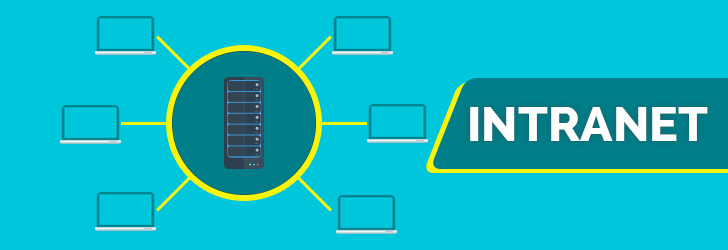
The term intranet is comprised of two words: "Intra" means internal and the "net" represents the network. The Intranet, therefore, can be defined as the internal network. It is a private network with access limited to the authorized users only. The Intranet can be as simple as a private website or it can be as big as private organizational infrastructure, accessed by only the authorized users. The intranet may not necessarily be connected to the Internet but they usually do. In typical intranet architecture, there are specific computers in a defined parameter where each computer in the intranet plays a specific role to provide common tools and features to every computer connected to the intranet. There are vendors that provide the intranet portal software like Share Point, Igloo, and Huddle.
The intranet and the Internet are similar in many ways. The intranet can be considered as the sandboxed version of the Internet. The intranet users can collaborate with other users within an organization via the software run by the servers hosted on the intranet. The intranet works on the same principle as the Internet. It uses the same protocols like TCP/IP for communication, FTP protocol for file transfers, and HTTP for web queries. It can run similar programs like Java, XML, Flash, and HTML. The users can have a similar web interface just like they have for the Internet.
Although the intranet is an internal network, it can be connected to the Internet to communicate with the outside world. An intranet is an isolated network with security appliances to provide security to the internal network from the external threats of the Internet. The other way to connect to the intranet remotely is through the extranet. The extranet requires the user to have credentials, authorization, and in some case the secure channel like VPN.
Intranet is used mostly by universities and organizations. For example, a company that develops web applications may require all of its employees to work in development and test environments before pushing live to the production environment. The intranet makes this requirement possible. The developers may test and update the code and share the updates with others through an intranet. The graphic designers may test the designs and upload them to the development server. Similarly, there are e-commerce companies having employees with segregated duties. Each employee share data with others about the orders, packaging, shipment, and tracking within the Intranet. Similarly, the intranet is used in the universities for sharing information amongst the students and the colleagues, helping students with the coursework, updating the students portal, and more.
Although the intranet is limited to the organizational boundaries with a limited audience, the benefits of the intranet are enormous. Whether it is spreading the information company-wide or communicating the goals to the employees; or it is about maintaining the company policy and documents online; the intranet is the solution.
Conclusion
The intranet provides flexibility and ease of access to the users. The intranet provides the users with all the required information and tools through a shared environment. Each user in an organization can easily access the information from his computer without going through an extensive authorization process. The intranet provides role-based or rule-based access to the users. The intranet makes it easy to share information amongst its members. Instead of sending the important notifications to each employee individually, the organizations advertise the notifications to the intranet's web interface where everybody can read and act accordingly. The intranet increases the productivity of an organization by making the operations fast. The users can access their tasks from the web portal and start working right away. This approach is also cost-effective. The intranet environment also helps the security department of the organizations to monitor the users' activities effortlessly.
Share this post
Leave a comment
All comments are moderated. Spammy and bot submitted comments are deleted. Please submit the comments that are helpful to others, and we'll approve your comments. A comment that includes outbound link will only be approved if the content is relevant to the topic, and has some value to our readers.

Comments (0)
No comment